Herpetofaunal Surveys of Biscayne National Park
Authors
Andrew Maskell, Marquette Crockett, J. Hardin Waddle, Kenneth G. Rice
Justification
Declines in amphibian populations have been recognized worldwide over many regions and habitat types (Alford and Richards 1999). No single cause for declines has been found, although acid precipitation, environmental contaminants, the introduction of exotic predators, disease agents, parasites, and the effects of ultraviolet radiation have been suggested. It is also possible that the interaction of several factors are causing the declines (Carey and Bryant 1995). A major factor in the loss of amphibian and reptile populations has been and continues to be the loss of habitat.
In response to concerns about the lack of basic knowledge of the amphibians and reptiles inhabiting Department of Interior lands, inventory programs are being instituted nationwide. The Center for Water and Restoration Studies of the U.S. Geological Survey, in collaboration with the Florida Cooperative Fish and Wildlife Research Unit, is conducting a reptile and amphibian inventory of the national parks of the southeast United States and the Caribbean. Biscayne National Park is a primarily aquatic park with small islands and spans over 173,000 acres. Sampling for herpetofauna in Biscayne National Park has been underway for the past eleven months.
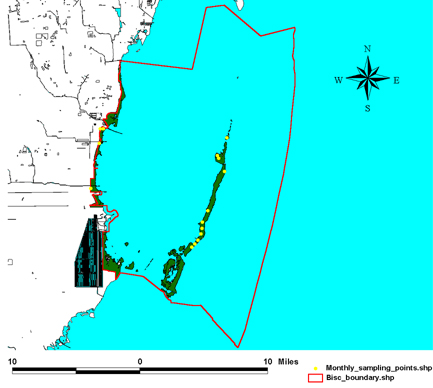
Amphibians
Sampling in Biscayne National Park has resulted in the detection of nine amphibian species (page 3). Six of the detected species are native to south Florida, while three have been introduced. Of the six native species of amphibians, only one (Gastrophryne carolinensis) has been found on the outlying islands of the park. In contrast, each of the three exotic species have been detected both on the mainland area of the park and on the islands.
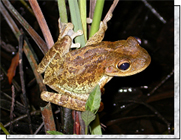 |
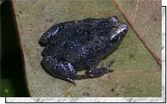 |
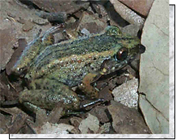 |
| Cuban Treefrog, Osteopilus septentrionalis |
Eastern Narrowmouth Toad, Gastrophryne carolinensis |
Greenhouse Frog Eleutherodactylus planirostris |
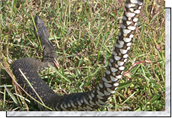 |
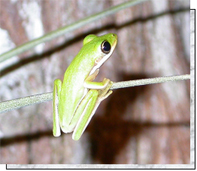 |
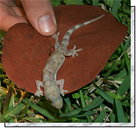 |
| Florida Water Snake, Nerodia fasciata pictiventris |
Green Treefrog Hyla cinerea |
Tropical House Gecko Hemidactylus mabouia |
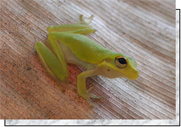 |
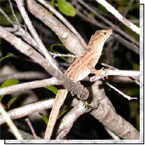 |
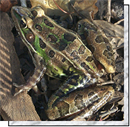 |
| Squirrel Treefrog Hyla squirella |
Brown Anole Anolis sagrei |
Southern Leopard Frog Rana sphenocephala |
Reptiles
Reptile sampling, which is done in conjunction with amphibian sampling, has uncovered 6 species (table 2). By far the most common reptile in Biscayne National Park is the brown anole, Anolis sagrei. The other reptile species have been encountered on a much less frequent basis, some of them with only one recorded sighting. It should be noted that while the tropical house gecko, Hemidactylus mabouia is also relatively common, it appears most often on the sides of building and around other disturbed areas. Although they have not been recorded by our sampling methods, leatherback, loggerhead, Kemps ridley, green, and hawksbill sea turtles, as well as American crocodiles are known to inhabit the aquatic areas of Biscayne National Park.
Table 1: Amphibian Detection Locations in Biscayne National Park
| Species | Mainland | Island |
|---|---|---|
| Hyla cineria | X | |
| Hyla squirella | X | |
| Rana Grylio | X | |
| Rana sphenocephala | X | |
| Gastrophryne carolinensis | X | |
| Acris gryllus | X | |
| Osteopilus septentrionalis* | X | X |
| Bufo Marinus* | X | X |
| Eleutherodactylus planirostris* | X | X |
*Denotes Introduced Species
Table 2: Reptile detection locations in Biscayne National Park
| Species | Mainland | Islands |
|---|---|---|
| Diadophis punctatus | X | |
| Nerodia fasciata pictiventris | X | |
| Sphaerodactylus notatus | X | |
| Anolis sagrei* | X | X |
| Hemidactylus mabouia* | X |
*Denotes Introduced Species
Summary
Biscayne National Park is home to many of the common species that make up the South Florida herpetofauna. However, due to artificial disturbance and high recreational use of the park, exotic species have spread and colonized much of the area. A lack of freshwater is the probable cause for the lack of amphibian species on the outer islands.
We would like to thank The National Park Service, The USGS, Amber Dove, Brian Jeffery, Chris Bugbee, and the staff of Biscayne National Park for assistance with this project.
All photographs are the property of Kenneth G. Rice.
Literature Cited
Alford, R. A. and S. J. Richards. 1999. Global amphibian declines: a problem in applied ecology. Ann. Rev. Ecol. Syst. 30:133-165.
Carey, C. and C. J. Bryant. 1995. Possible interrelations among environmental toxicants, amphibian development, and decline of amphibian populations. Environ. Health Perspec. 103(Suppl. 4):13-17.
Information on sea turtles provided by Biscayne National Park.
Citation
Maskell, A., M. Crockett, J.H. Waddle and K.G. Rice. (2003, April). Herpetofaunal Surveys of Biscayne National Park. Poster presented at the Greater Everglades Ecosystem Restoration Conference.




